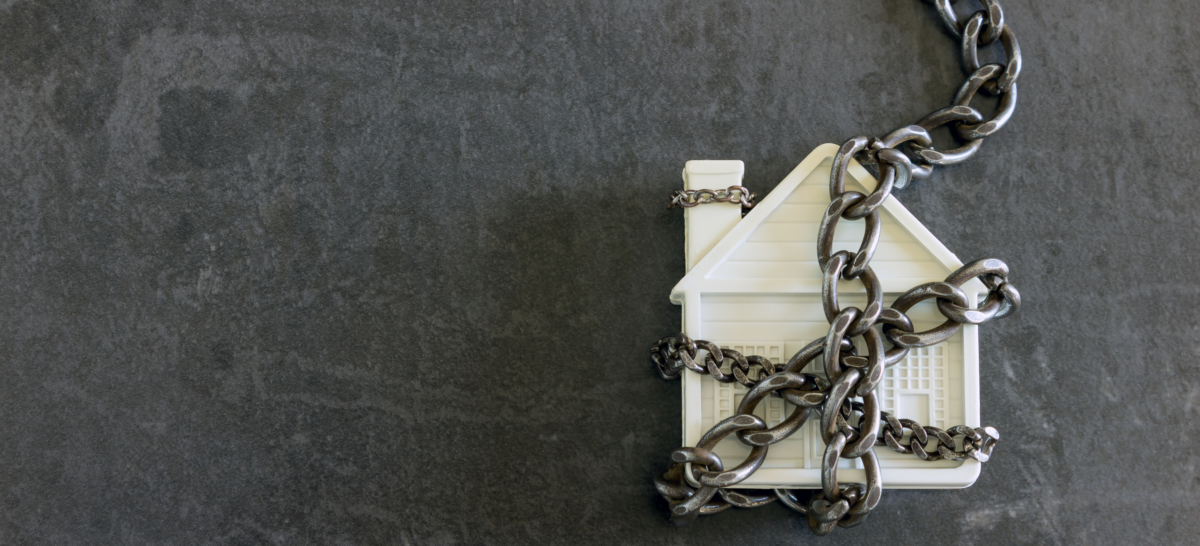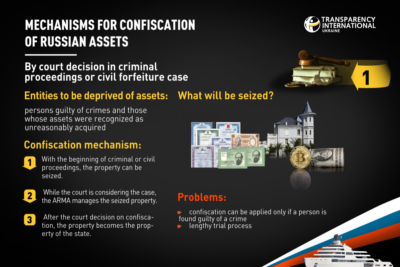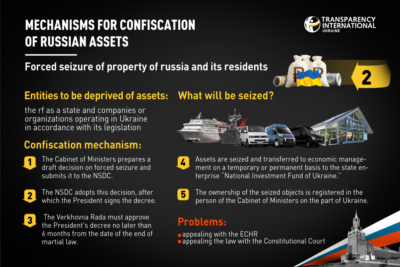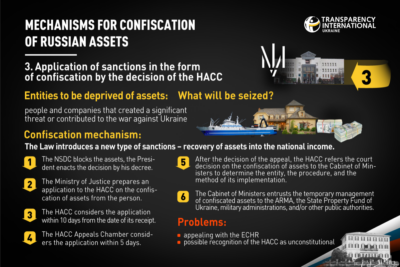

Every day, the war takes people, property, and infrastructure from Ukraine. For this, the rf and all the russians involved should be punished fairly. While the International Court of Justice, the International Criminal Court, and the national courts of Ukraine consider russian crimes, our country can also influence the people and companies that supported or financed the full-scale war.
You can’t bring people back, but russians can compensate at least for property losses. Ukrainian legislation allows the seizure of russian assets. However, confiscation mechanisms have certain nuances and risks. Let us tell you which ones.
1. Confiscation by court decision in criminal proceedings or a civil forfeiture case
 Entities to be deprived of assets: persons guilty of crimes under certain articles of the Criminal Code of Ukraine, and persons whose assets were recognized as unreasonably acquired.
Entities to be deprived of assets: persons guilty of crimes under certain articles of the Criminal Code of Ukraine, and persons whose assets were recognized as unreasonably acquired.
What will be seized?
In criminal proceedings:
property owned by the convict, in particular their share in joint ownership, the statutory fund of business entities, money, securities and other valuables, including those that are in accounts, deposits, or storage in financial institutions, as well as property transferred to convicts in trust management.
For civil forfeiture:
funds (cash, funds held in bank accounts or stored in banks or other financial institutions), other property, property rights, intangible assets, cryptocurrencies, the amount of reduction of financial liabilities, as well as work performed or services rendered.
Confiscation mechanism:
1. With the beginning of criminal or civil proceedings, the property may be seized to be confiscated later. Seizing is possible provided that the court makes an appropriate decision.
2. While the court is considering the case, the Asset Recovery and Management Agency can manage the seized property if there is an appropriate court decision.
3. After the court decision on confiscation, the property becomes the property of the state.
Risks:
1. Confiscation can be applied only if a person is found guilty of a crime or their assets are found unjustified.
2. A lengthy trial process.
This mechanism is the safest in terms of potential appeals with international courts. At the same time, it is problematic that confiscation can be applied only to persons who have committed crimes, or to local and state officials who illegally acquired property. Therefore, the law has a very narrow spectrum of action, under which most russian assets do not fall.
2. Law on the forcible seizure of property of russia and its residents No. 2116-IX
 Entities to be deprived of assets:
Entities to be deprived of assets:
the russian federation as a state and companies or organizations operating in Ukraine in accordance with its legislation, whose founder (participant, shareholder), beneficiary or member (through a share in the authorized capital, land share, etc.) is directly or indirectly the rf or a legal entity, whose beneficiary or founder (participant, shareholder) is the rf.
What will be seized:
movable and immovable property (apartments, land plots, cars, houses, offices, etc.), funds, deposits in banks, securities, corporate rights, other assets located (registered) on the territory of Ukraine and directly or through affiliates belonging to the russian federation and its residents.
Confiscation mechanism:
1. The Cabinet of Ministers prepares a draft decision on the forced seizure of property rights of the rf and its residents and submits it to the National Security and Defense Council of Ukraine (NSDC).
2. The NSDC decides to forcibly seize some objects of property rights in Ukraine, after which the President of Ukraine signs a decree that puts this decision into effect.
3. No later than 6 months from the date of the end of martial law, the Verkhovna Rada must approve the President’s decree by adopting the relevant law.
4. Subsequently, the objects of ownership are seized and transferred to economic management on a temporary or permanent basis to the state enterprise “National Investment Fund of Ukraine,” coordinated by the Cabinet of Ministers.
5. The ownership of the seized objects is registered in the person of the Cabinet of Ministers on the part of Ukraine.
Risks:
1. Non-compliance with the requirements of the European Convention on Human Rights (ECHR). The law does not contain any mechanism for protecting the rights of legal entities (for example, through a legal process) whose property will be seized. This could potentially be recognized as a violation of Art. 13 of the ECHR, which guarantees the right to an effective remedy. It is necessary to introduce the possibility of contesting the confiscation by a russian resident company with the administrative court of Ukraine.
2. Contesting the law with the Constitutional Court: the law provides for the seizure of objects of property rights without any compensation, which contradicts Art. 41 of the Constitution of Ukraine.
Unresolved issues:
1. It is unclear who and how in the Cabinet of Ministers collects data to prepare a draft decision on the forced seizure of property right objects of the rf and its residents.
2. How will the National Investment Fund of Ukraine manage the seized assets? What statutory acts regulate this process? Will a sufficient level of control and a transparent reporting mechanism be ensured by the state-owned enterprise, as, for example, it is provided for the ARMA?
3. What is meant by the term “indirectly” to be a beneficiary or a member of legal entities-residents of the rf? How will such “indirectness” be determined?
An example of the application of this seizure mechanism is Law No. 7371.
According to it, Ukraine is to be granted ownership of the financial assets of the subsidiaries of russian banks — shares of Prominvestbank owned by the state development corporation VEB.rf and shares of the International Reserve Bank (IR Bank, formerly Sberbank, Kyiv), owned by Sberbank of russia.
These assets were to be forcibly seized within 10 days from the date of publication of the Presidential Decree. The Cabinet of Ministers and the Deposit Guarantee Fund with the participation of the National Bank were supposed to ensure the confiscation process, but suspended it due to the lack of a special account with the State Enterprise “National Investment Fund of Ukraine,” where the confiscated assets should be transferred. As of August, according to our information, the assets have not yet been transferred to the SE “National Investment Fund of Ukraine.”
This mechanism can cover a fairly wide range of legal entities related to the rf by corporate relations. It is as straightforward and simplified as possible, which is explained in the law itself by social necessity (including military). At the same time, TI Ukraine additionally draws attention to the risks that may befall the application of the law in practice.
3. Law on increasing the effectiveness of sanctions on the assets of individuals No. 7194
 Entities to be deprived of assets:
Entities to be deprived of assets:
people and companies that created a significant threat to the national security, sovereignty, or territorial integrity of Ukraine or significantly contributed to it, including through financing, the commission of such actions by other persons, as well as residents of russia — legal entities defined by Law No. 2116-IX.
Confiscation mechanism:
The law introduces a new type of sanctions — the recovery of assets (confiscation) into the national income. This sanction may be applied only by decision of the High Anti-Corruption Court and during the period of martial law.
Stages of confiscation:
1. The NSDC, by its decision, blocks assets. The President by decree enacts it, thus depriving individuals of the right to use and dispose of the assets.
2. The Ministry of Justice prepares a statement to the HACC on the application of a sanction to a person in the form of confiscation of assets.
3. The Anti-Corruption Court shall consider the application within 10 days from the date of its receipt.
4. After the decision is made, the HACC Appeals Chamber shall consider it within 5 days from the date of receipt of the complaint.
5. If the Appeals Chamber confirms the decision of the HACC on the confiscation of assets, the decision is referred to the Cabinet of Ministers to determine the entity, the procedure, and the method of its implementation.
6. The Cabinet of Ministers may entrust the temporary management of confiscated assets to the ARMA, the State Property Fund of Ukraine, military administrations and/or other public authorities, economic entities of the public sector of the economy.
Unresolved issues:
1. How is it decided to whom the Cabinet of Ministers will entrust the temporary management of confiscated property?
2. Why additionally distinguish legal entities-residents of russia as sanctioned entities, if a separate law No. 2116-IX is designed for them?
Risks:
1. The proposed deadlines for consideration of the case by the HACC, as well as the deadline for contesting the decision of the first instance, are too short. This may be grounds for declaring a trial inconsistent with Art. 6 (right to a fair trial) and Art. 14 (right to an effective remedy) of the European Convention on Human Rights.
2. Recognition of the HACC as unconstitutional in accordance with Article 125 of the Constitution, which provides that the judiciary in Ukraine is built on the principles of territoriality and specialization and is determined by law.
3. The non-compliance of the competence of HACC judges, as defined by Articles 69, 83 of the Law “On the Judicial System and the Status of Judges” and Article 7 of the Law “On the High Anti-Corruption Court,” consists in the consideration of cases, related to corruption, with the requirements for the consideration of cases on the imposition of sanctions.
4. The law provides for the possibility of confiscation of property after imposing a sanction on a person in the form of blocking. Thus, to persons who were subject to blocking sanctions before the entry into force of this Law (for example, Medvedchuk) such a sanction will need to be applied again to confiscate their assets under this mechanism.
In general, the Law provides for a more balanced procedure for recovering objects of ownership into the national income and an exhaustive list of grounds for confiscation of property of a person in comparison with the previous law. At the same time, questions remain about the distribution of functions for the implementation of this mechanism among institutions and its compliance with the standards of the European Court of Human Rights.
The confiscation of russian assets should benefit Ukraine, since the seized property, funds, and other assets will be used for defense and restoration of our state. All legislative initiatives offer different confiscation mechanisms, which at the same time have a common goal — to bring the perpetrators to justice and compensate for the losses caused by them.






